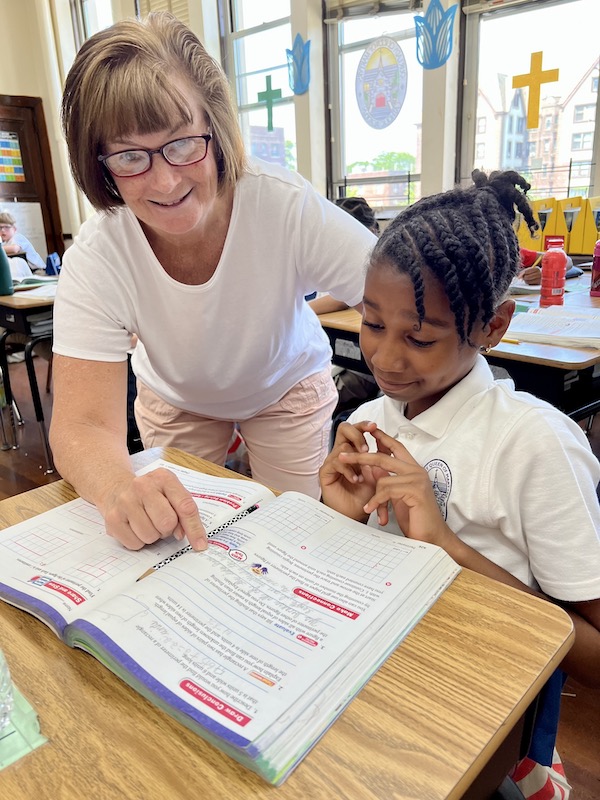
FOREST HILLS — Liz McNally has been teaching third grade at Our Lady Queen of Martyrs Catholic Academy in Forest Hills for so long, some of her students are the children of students she taught years ago.
“Now that I’ve been here a while, there’s another generation of students coming through whose parents I taught,” said McNally, who has been at the school for 38 years — and has no plans to retire anytime soon.
She isn’t the only veteran at Our Lady Queen of Martyrs, where at least half the teaching staff has 20 years or more experience.
Principal Anne Zuschlag attributes it to the sense of community her school offers. “The environment and the culture, I think, is one that people would want to be a part of. And when they’re here, they want to stay,” she added.
Like many of her teachers, Zuschlag is a veteran educator. She has been at Our Lady Queen of Martyrs for 30 years.
While the Diocese of Brooklyn does not keep statistics on teacher retention rates, there is anecdotal evidence that Catholic schools in the diocese have teachers boasting decades of experience, which translates into low attrition rates.
That’s not the case everywhere. According to the New York City Department of Education, the number of teachers who left their jobs either through retirement or resignation has decreased in recent years but did increase between the 2019-2020 and 2020-2021 school years.
In the 2019-2020 school year, 4.2% of teachers left. That figure jumped to 5.8% during the 2020-2021 school year.
As of October 2022, 4% of public school teaching positions in the U.S. were vacant, according to the National Center for Educational Studies. The center also found that 18% of public schools had at least one vacancy and 27% had multiple vacancies.
Other troubling signs emerged in recent years. In 2019, the year before the start of the pandemic, the RAND Corporation conducted a survey of 5,646 public school teachers across the U.S. and found that 1 in 6 teachers intended to leave their jobs, most citing work stress as the reason.
One year later, RAND did another survey, and this time, 1 in 4 teachers said they wanted to leave their jobs.
In April, Educators for Excellence released its annual “Voices from the Classroom” survey of 1,000 teachers from across the country and found that while 80% of the respondents said they would return to their jobs next term, only 14% would recommend teaching as a profession.
“Unfortunately, the survey shows us that teachers do not have the professional autonomy, support, or resources to effectively support their students, especially those who have been historically underserved, leaving many educators overwhelmed and disheartened,” said Sydney Morris, co-founder and co-CEO of Educators for Excellence.

Getting support is important to teachers, said McNally, who listed it as one of the reasons she has remained on the job. “I think it’s the people, the administration. It’s the other faculty members. It’s the parents. And everybody supports each other in the good times and the bad times. We’re basically like a family,” she explained.
Cathy Kaminsky, who is retiring at the end of this school year after 37 years as a kindergarten teacher at Our Lady Queen of Martyrs, said she thinks the significant role faith plays in a Catholic school classroom is a factor in teacher longevity — the fact that teachers can feel free to express their love for Jesus.
“We’re allowed to teach the faith, which I think really makes a huge difference between here and public school,” she added.
Kaminsky has seen many changes in education in her years as a teacher, including technological advancements.
But some things have remained the same. “There have been definite changes in pedagogy, for sure. The use of technology in the classroom has created different opportunities for teaching strategy. But the bottom line here is it’s about educating the entire child. Not just teaching them to read and write but also just teaching them to be just morally good people. And I think that’s what sets us apart,” she said.
Still, Catholic schools face challenges retaining teachers. The reason is usually salary-related, Zuschlag said. Public schools pay higher salaries.
“I wish there was a magic bullet. Unfortunately, economically that’s what drives a lot of the Catholic school teachers out, especially the younger teachers. I don’t think any of them ever leave because they’re not happy. Every teacher that I’ve had leave was crying when they announced they were leaving. It’s because financially it’s not something they’re able to sustain,” she explained.
A selling point, however, is the fact that there is less bureaucracy. Because the Catholic school system is smaller than the behemoth public school system, questions get answered quickly and there are fewer forms to fill out — something teachers appreciate.
The story of McNally’s hiring is a perfect example. “I was hired as a teacher at the last minute. I did my interview on Labor Day right after I graduated from college. I was hired the next day. I really didn’t go through a big process,” she recalled.
